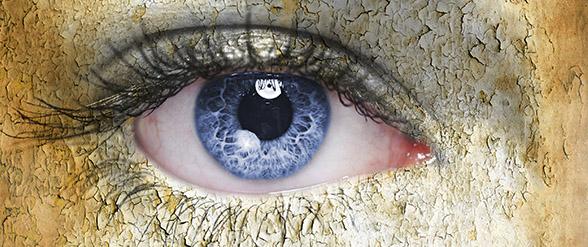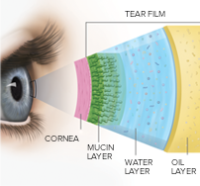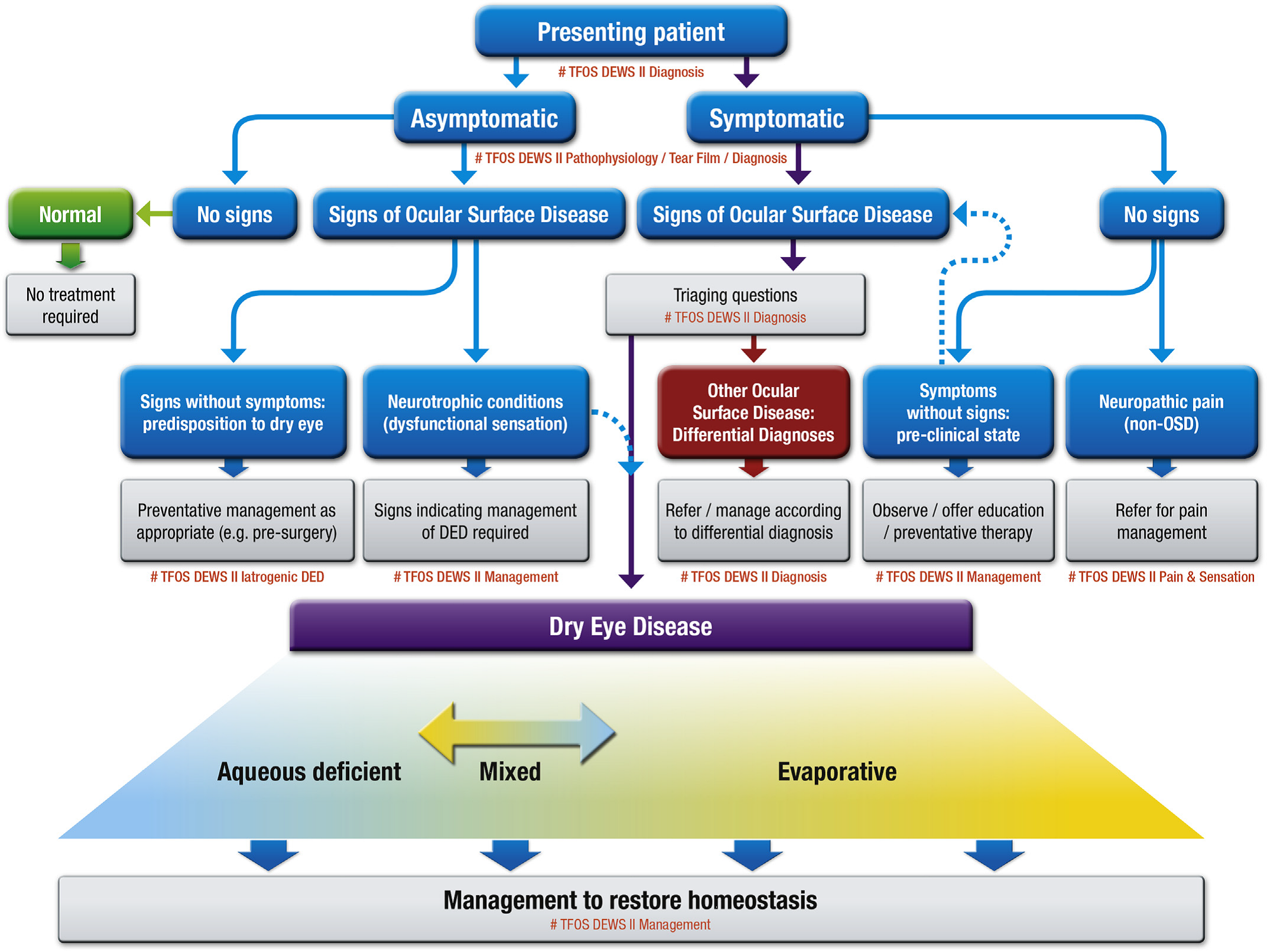What Causes Dry Eyes?
Dry eye is an eye condition that’s characterized by reduced volume of tears and/or a dysfunctional tear film layer. Dry eye syndrome have a very wide range Some common symptoms of dry eyes include:
- Red, stinging, burning, painful, or scratchy sensation in the eyes.

- Gritty or foreign body sensation in the eyes.
- Itchy eyes, with or without stringy mucus in/or around the eyes.
- Intermittent blurred vision or fatigued eyes, especially when working on the computers.
- Sensitivities to light with or without difficulties, especially with nighttime driving.
- Difficulties with wearing contact lenses.
- Watery eyes, which is the body’s response to the irritation of dry eyes.
The purpose of each blink of the eyelids is to spread tears across the entire front surface of the eye, in order to provide lubrication, to rinse away foreign matters, to reduce risk of infections, and to ultimately help keep the surface of the eyes smooth and clear. Once the blink is completed, excess tears are drained from the eyes by small ducts in the inner corners of the eye lids, where it drains into the back of the nose/throat. The severity of the dry eyes are greatly dependent on the imbalance between these systems, the production, quality, and the drainage of tears from the eyes:
- Your tears are produced by several glands around the eyelids and usually diminish with advanced age, with side effect from medications, and with certain medical conditions.
 Environmental conditions (wind, dry climate, low humidity), can contribute to increased tear evaporation, thus, multiple symptoms of dry eye can progress.
Environmental conditions (wind, dry climate, low humidity), can contribute to increased tear evaporation, thus, multiple symptoms of dry eye can progress.- Your tears are made up of three specific and important layers:
- The oil, or lipid layer: this is the most outer layer of the tear film, and its main purpose is to completely seal the tear film, to reduce the evaporation of the tears.
- The water, or aqueous layer: this middle layer is mainly water. Its main purpose is to keep the eyes lubricated, as well as to rinse away foreign matters, thus, reducing the incidents of eye infections.
- The mucin layer: this inner layer helps to nourish the underlying cornea, as well as to help assist in keeping the tears adhere to the surface of the eye.
Dry eyes can develop for many reasons, and many factors may increase the risks for dry eyes. These factors include, but not limited to the following:
- Aging: Dry eye syndrome may occur at any age, however, it does become more prevalent later in life, especially after 40 years old. Dry eyes are a part of the natural aging process. The majority of people over age 65 experience some symptoms of dry eyes.
- Computer use: When staring at computer, smart phones, and/or other digital devices, we blink a lot less frequently and with incomplete closures, which ultimately leads to more tear evaporation and an increased risk for dry eye symptoms.
- Contact lenses: Over wear, poor contact lens solution, and sleeping with contact lenses contributes greatly to dry eye problems. Case in point, dry eye discomfort is one of the main reason why people discontinue contact lens wear.
- Environmental conditions: Exposure the environment can exacerbate symptoms of dry eyes. For instance, smoke, wind, and dry climates increase tear evaporation, thus, causing dry eye symptoms.
- Eyelid problems: If left untreated, incomplete closure of the eyelids when blinking, whether by age, cosmetic surgery, or other causes, can cause sever dry eyes, and can lead to severe infections.
- Frequent flying: Frequent flyers exposed to the dry air in the cabins of airplanes can lead to dry eye problems.
- Gender: Because of the natural changes of hormones during pregnancies, contraceptives, and menopause, women are more likely to develop dry eyes.
- Indoor environment: Tear evaporation increases due to decreased humidity indoor when exposed to prolonged air conditioning, ceiling fans, and heating systems.
- Medical conditions: Systemic diseases, such as diabetes, thyroid-associated diseases, lupus, rheumatoid arthritis, and Sjogren’s syndrome, contribute to dry eye problems. Other problems related to inflammation of the eyelids or surfaces of the eyes, can also cause dry eyes to develop/progress.
- Medications: Some medication, for example, antihistamines, decongestants, blood pressure medications, antidepressants, and birth control pills, can reduce tear production.
- Menopause: Post-menopausal women are at a much greater risk of dry eyes than men of the same age.
- Other factors:
- Refractive surgery, or LASIK, may reduce overall tear production and can contribute to dry eyes.
- In addition to dry eyes, smoking are linked to serious eye issues, including macular degeneration, cataracts, and uveitis.
Dry Eye Diagnosis?
Dry eyes evaluations are medical visits with emphasis on the evaluation of the quantity and quality of the tears produced by the eyes. These evaluation may include:
- Complete patient medical history to assess patient’s symptoms, health problems, medications, or other environmental factors that may contribute to the dry eye symptoms.
- Comprehensive examination of the eye, including anterior segments, lid structures, and blink mechanisms.
- Evaluate for the quantity and quality of tears with specialized dyes to observe tear flow to determine any defects to the anterior segments.
Once all the information are compiled, from the special testing, Dr. Q can then determine if you have dry eyes, and will advise on the appropriate and necessary treatment options.
How Are Dry Eyes Treated?
Dry eyes are truly a chronic condition and customized treatment plans/regimens are based on each individual’s symptoms, ocular presentation, and lifestyles. The goal of these customized treatment plans are to keep the eyes health and comfortable, and to prevent any compromises in vision:
- Increasing amount of tears: Over the counter preservative-free artificial tears are usually adequate and manageable for most cases of mild dry eyes symptoms, and can be utilized as often as needed in order to supplement the natural tear production.
- Conserving natural tears: Natural tears are drained from the eye via the punctums, located on the inner lid area of the eyes. By keeping the natural tears in the eyes longer, once can reduce the symptoms of dry eyes. This can be accomplish by blocking the tear ducts (punctums) through which the tears normally drain. The tear ducts are blocked with tiny silicone/gel-like plugs, which can be removed. However, if a more permanent solution is required, surgical interventions can permanently close the tear ducts.
- Treatment of ocular surface inflammation: Anti-inflammatory eye drops, warm compresses, lid massages, or eyelid cleaners can be part of the custom regimen in order to decrease inflammation on the ocular surface.
 Overall, dry eye syndrome is an insidiously chronic and typically progressive condition. Dry eye treatment can be managed successfully, but completely dependent on the cause and/or severity of the condition. The vast majority of cases can and will be managed successfully, and can provide continual comfort, clarity, and consistency of vision throughout the day.
Overall, dry eye syndrome is an insidiously chronic and typically progressive condition. Dry eye treatment can be managed successfully, but completely dependent on the cause and/or severity of the condition. The vast majority of cases can and will be managed successfully, and can provide continual comfort, clarity, and consistency of vision throughout the day.


